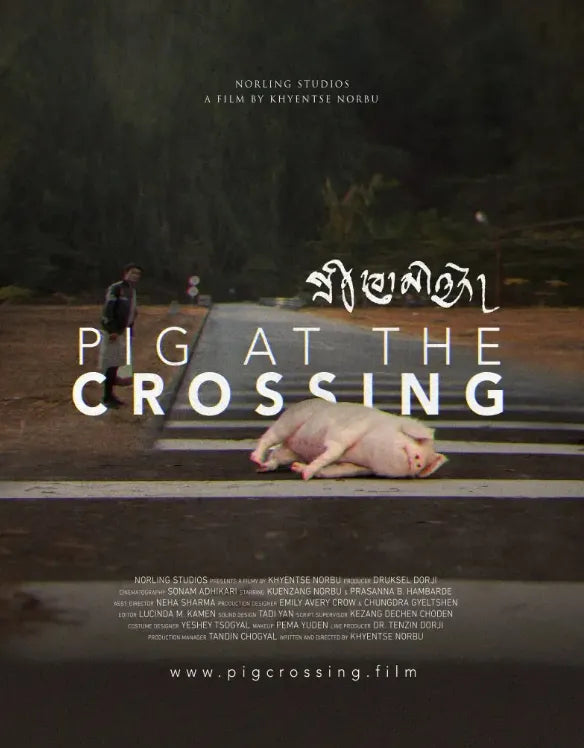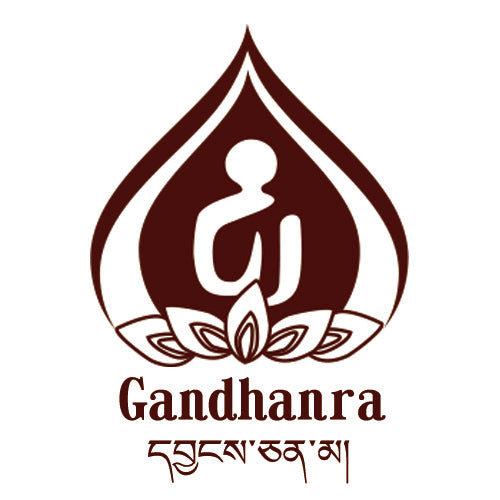
The Revivalist - Reflections brought by "The Pig at the Crossroads"

The film has had its global online premiere on May 11th this year
(By Quentin Nobu)

བདག་སོགས་འགྲོ་དྲུག་འཁོར་བའི་སེམས་ཅན་རྣམས།
ལས་ངན་སྡིག་སྒྲིབ་ཐམས་ཅད་བྱང་བ་དང།
མཐོ་རིས་ཐར་པའི་ལམ་ལ་རབ་གནས་ཤིང།
རྫོགས་པའི་སངས་རྒྱས་མྱུར་དུ་འགྲུབ་པར་མཛོད།
རྒྱུ་དང་འབྲས་བུའི་ཉེས་དམིགས་ཕན་ཡོན་དང།
རང་རང་ལས་ཀྱི་རྣམ་པར་སྨིན་པ་ཡི།
སྡུག་བསྔལ་མྱོང་ལུགས་མཐོང་བའི་མེ་ལོང་འདི།
འགྲོ་བ་ཀུན་ལ་ཕན་ཕྱིར་བསྟན་པར་བྱ།
ཁྱད་པར་དུག་ལྔས་གཟིར་བའི་འགྲོ་བ་ལ།
Who have committed all kinds of sins and offenses,
Still reside in the pure land of liberation,
To quickly attain the state of perfect enlightenment.
The effects of our actions, both good and bad,
Will manifest as the results of our karma,
Reflecting like a clear mirror,
For the benefit of all sentient beings.
Especially for those afflicted by the five poisons.
Excerpt from "The Liberation Iron Hook" in the biography of Karma Wangchang by the Revenant (འདས་ལོག་ཀརྨ་དབང་འཛིན་གྱི་རྣམ་ཐར་ཐར་པའི་ལྕགས་ཀྱུ།),
As narrated by Karma Wangchang,
Compiled by a Bhutanese scholar in the first half of the 17th century.

In the mid-19th century, from the Zhubagaju sect, a private collection
Detail: Guanyin rescuing sentient beings in hell

A handwritten manuscript from the mid-17th century, housed in the National Library of Bhutan.
A pig, emitting a foul smell from head to toe, lay quietly on the bed; just a moment ago, I, suffering from a malignant disease, was being observed by relatives and neighbors on that bed, their eyes full of fear and unease. Now, relying on the wooden door, I seemed to be "invisible" to them. They gathered around the pig, some crying, some seemingly whispering to each other. In an instant, I was carried away from that room full of pain by an invisible force, and I believe that when people imagine the next plot in this story, they can refer to the recent critically acclaimed movie "Pigs on the Crossroads", a masterpiece about Tibetan views on life and death and the concept of the "bardo".

"Theme of Saving Souls in the Intermediate State: Calling Hell with a Big Voice"
In the late 18th century, from the collection of the Rubin Museum.
The great hell is called the "Eight Hot Hells",
Crying in agony while in a scorching iron room
When I choose to watch this film, my mind is constantly filled with a group that had a special influence in the classical period of Tibet: the revenants. The slightly eerie self-description at the beginning of the article comes from the mouth of a revenant woman living in the 16th century, Lingzaquji (གླིང་བཟའ་ཆོས་སྐྱིད་).

The reincarnated soul, Dawa Lhamo (1910-1941), was the mother of Chardu Zugu(ལྕགས་མདུད་སྤྲུལ་སྐུ་;1930-2002).
Our understanding of Lingza Quji mainly comes from the biography she dictated, which also serves as the initial paradigm of posthumous autobiographies. It is important to note that this does not imply Lingza Quji was the first posthumous figure in Tibetan history. Throughout the past thousand years from the 11th to the 20th century, almost every century in Tibet witnessed the emergence of influential posthumous figures. Nangsa Woebum(སྣང་ས་འོད་འབུམ་), a renowned Tibetan opera actor, is considered a posthumous figure who lived between the 11th and 12th centuries. The posthumous figure "White-Haired Woman"(འདས་ལོག་སྐྲ་དཀར་མ་) from the 12th century provided revelations to Darlong Kagyu lineage master Zaxi Be (1142-1210) on the flourishing of his teachings. The 15th-century sibling posthumous figures, whose deeds in western Tibet are preserved in the writings of Sakya scholars. Notably, the most striking among all posthumous texts is the dictated biography of Karma Wangzeng, which provides a detailed account of the "bardo stage" and continuously influences related traditions in the broader Himalayan region.

"Manifestation of White Tara: The Biography Thangka of the Restorer Jnanasavara"
At the end of the 19th century, a private collection of the Ernst family
Tara is the main deity most commonly found in the "Restorer Text"

There is a difference in detail between the play script and the biography.

"The founder of Dzogchen Jue, Zaxi Bei"
At the end of the 13th century, a private collection
In some of the passed-down documents of Dzogchen Jue
The "white-haired woman" is considered one of his earliest disciples.

"The Silent and Wrathful Deities in the Intermediate State"
Late 18th century, Rubin Museum of Art Collection.
In Tibetan language, the resurrected individual is generally referred to as འདས་ལོག་ ('das log), where 'das indicates death and log implies return. In fact, this term reveals three characteristics possessed by all resurrected individuals. Firstly, the resurrected individuals have experienced a near-death experience or have entered a state of death. Nangsa Woebum died from being falsely accused by her in-laws, ultimately beaten to death; Lingsa Quji and Gawa Wangzeng died from physical and mental illnesses (their biographies extensively described their daily pain). Secondly, the resurrected individuals have returned to the world after experiencing a series of multi-layered "bardo experiences", some abandoning worldly life to become practitioners, while others become leaders of folk religious groups. Lastly, the resurrected individuals are given a daunting mission, which is to spread the law of causality to the world and continuously describe the hellish landscapes they have seen with their own eyes. Among these three characteristics, the last one is particularly important. Only when they narrate can people know about that interstitial time between death and return.
Let us take the description of the resurrected individual, Gawa Wangzeng, as an example to see the ideology proclaimed by the "resurrected individual text". The resurrected individuals will clearly perceive the disappearance of their physical body (but they still cannot determine if they have died), the reactions between various elements will become more apparent. While perceiving all of this, the anxiety and fear arising from evil karma from their previous lives will also persist. Subsequently, an illuminating voice will appear, telling her not to cling to the physical body and that facing the mind and knowing impermanence is the right path of practice. The "bardo experience" of Gawa Wangzeng will unfold from this point onwards. A group of spirits surround her, including the spirits of the deceased and non-human creatures wandering in the mountains and forests for centuries, their tragic situation causing the resurrected individual immense pain. During the journey, Gawa Wangzeng encounters her earthly parents, her ordained uncle, and her deceased brother. Her parents ignore her, her uncle teaches her, and her brother earnestly explains the path of life and death (pure philosophical reflection). Finally, with the blessings of Sky-walker Mother and Tara, Gawa Wangzeng calmly accepts her mission as a resurrected individual. However, when she sees her corpse as that of a dog, she still feels extremely uncomfortable.

19th century, private collection

20th century, Nepal, collection of the Rubin Museum



End of the 19th century, private collection

